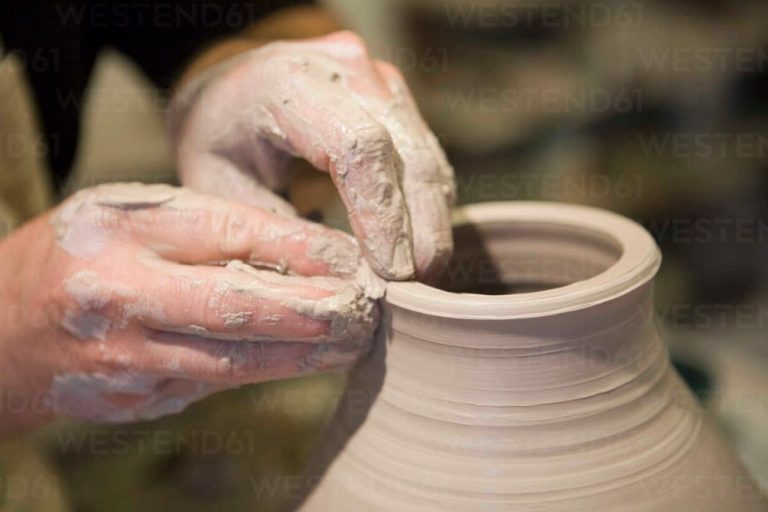Can You Mix Clay To Make Different Colors?
Clay is an earthy material made up of fine-grained minerals such as kaolinite that can be molded when wet and retains its shape when fired in a kiln or oven. Clay comes in a variety of natural colors depending on its mineral composition, from white and grey to red and brown.
Mixing different colored clays together allows artists to create a wide spectrum of colors for their ceramic projects. By understanding color theory and the basics of clay chemistry, you can blend virtually any hue. This provides limitless options for glazing and decorating pottery, sculptures, tiles and other clay artworks.
Primary Clay Colors
The primary colors in clay are red, yellow, blue, white and black. These colors are considered primary because they cannot be created by mixing other colors. When working with clay, having these pure primary colors available allows you to mix and create any other hue.
Red, yellow and blue are the three main primary colors. They form the foundation of the color wheel. Combining red, yellow and blue clay in different proportions allows you to make secondary and tertiary colors.
White clay is also primary. Adding white clay to any other color makes it lighter and more pastel. Black clay is primary too. Adding black clay makes colors darker and more muted.
Having a good stock of quality pure red, yellow, blue, white and black clay is essential for any clay color mixing. These pure primary colors give you the building blocks to create an unlimited rainbow of clay color combinations.
Secondary Clay Colors
Secondary colors are created by mixing two primary colors together in equal parts. The three secondary clay colors are green, orange, and purple.
Green
Green is made by mixing blue and yellow clay in equal amounts. When blue and yellow combine, they neutralize each other’s brightness and create the more subdued green. Adding more yellow will make a lighter green, while adding more blue will create a deeper forest green.
Orange
Orange clay is made by mixing red and yellow clay together. Orange sits between the warmth of red and the brightness of yellow on the color wheel. Adding more red clay will create a deeper, reddish orange, while extra yellow makes a golden orange.
Purple
Purple is created by mixing red and blue clay. Red and blue are both primary colors with a lot of pigment, so combining them makes the rich secondary color purple. Adding more red will yield a red-violet, while extra blue makes a blue-violet.
Tertiary Clay Colors
Tertiary colors are created by mixing a primary and secondary clay color. These colors have names that indicate the two colors used to make them. Some examples of tertiary clay colors include:
Red-orange – Made by mixing red and orange clay. Red-orange has a vibrant, energetic appearance.
Yellow-orange – Created by mixing yellow and orange clay. This bright color evokes warmth and creativity.
Yellow-green – Formed by mixing yellow and green clay. Yellow-green has a lively, springlike feeling.
Blue-green – Produced by blending blue and green clay. Blue-green has a cool, tranquil vibe.
Blue-purple – Made by mixing blue and purple clay. This rich tertiary has a regal, mysterious quality.
Red-purple – Created by combining red and purple clay. Red-purple has a luxurious, passionate energy.
Mixing the clay in different ratios will yield different shades of these tertiary colors. Get creative and explore the range of captivating tertiary hues!
Complementary Clay Colors
Complementary colors are pairs of colors that are opposite each other on the color wheel. When mixed together, they create a gray or brown tone. The most common complementary color pairs in clay are:
Red and Green
Red and green are strong complements. When you mix red clay with green clay, you will get earthy browns and grays. The bright intensity of the red and green balance each other out.
Blue and Orange
Blue and orange are powerful complements with a strong visual contrast. Mixing blue clay with orange clay results in muted browns and grays. Using small amounts can tone down the brightness.
Yellow and Purple
Yellow and purple complement each other with a bright, vivid pop. Combining yellow clay and purple clay makes browns and grays that are less dull than other complement pairs. The resulting colors are often tan or beige.
Balancing complementary colors is an important technique for neutering bright clay colors. Complements naturally desaturate each other into more neutral tones.
Color Mixing Techniques
There are several techniques that can be used when mixing clay colors to achieve beautiful and interesting effects:
Blending
Blending is one of the most basic clay color mixing techniques. It involves taking two or more colors of clay and kneading them together thoroughly to create a smooth, uniform new color. Start with equal parts of each color and then adjust the proportions until you achieve the desired shade.
Marbling
Marbling involves lightly mixing two or more colors together so they retain some of their individual characteristics. The clay will have swirls and streaks of the different colors. To marble clay, roll each color into a log or ball. Gently press them together, twisting slightly, without over-mixing. The more the colors are blended, the more uniform the final marbled clay will become.
Caning
Caning utilizes thin rods of different colored clays that are stacked in layers, compressed, then sliced to reveal the colorful patterned cross-sections. By using multiple colors of clay in different designs, stunning multicolored canes can be created. These can then be reduced into thin slices and applied to the surface of clay projects.
Skinner Blends
Skinner blends involve very gradually blending one color into another to create a fade effect. To do this, condition two colors of clay until soft and pliable. Form each into a square sheet. Place one sheet on top of the other and gently press together. Carefully stretch and fold the clay repeatedly, working from dark to light. This will gradually blend the two colors into each other seamlessly.
Achieving Specific Colors
When aiming for specific colors, like realistic skin tones, bright primaries, or earthy natural hues, the mixing technique and clay types used can make all the difference. Here are some tips for achieving certain colors with clay:
Skin Tones
Mixing skin colors that look natural and not too pink or orange can be tricky. A good starting point is a beige or light brown base clay. Then add a small amount of red, yellow, white and blue clays in varying amounts. Adding more red will warm up the tone, while extra yellow gives a golden undertone. A touch of white makes it lighter, and a tiny bit of blue helps neutralize and desaturate the skin color.
Bright, Saturated Colors
For pure, vivid hues like primary colors, choose highly pigmented polymer or modeling clays rather than natural earthen clays. Start with a white base, then add small amounts of the pure color until you achieve the desired saturation. Avoid mixing in complementary colors, which will dull the brightness.
Earth Tones
For organic, earthy colors found in nature, work with natural earthen clays and avoid adding white, which can make the tones seem artificial. Mix in small amounts of complementary colors like greens, browns and tans to achieve rich, complex earth tones. Allow the natural clay colors to shine through.
Test colors on a tile first before applying to a sculpture. Record recipes that work for certain hues so they can be replicated. With practice and an understanding of color theory, you can mix clay to achieve a wide spectrum of tones.
Color Mixing Recipes
When creating clay pieces, artists often want to achieve specific colors but may not have the exact pre-made polymer clay in that shade. By blending different colors of polymer clay, you can create an endless spectrum of custom colors and effects. Here are some recipes for mixing popular polymer clay colors:
Mixing a Peach Color
To make a peach clay color, mix together:
- 2 parts white polymer clay
- 1 part yellow polymer clay
- A small amount of red polymer clay
Start with a white clay base, add yellow to reach the desired hue, then add just a touch of red clay to give it a peachy tone. The more red you add, the more orangey the color will become.
Mixing a Lime Green Color
For a bright lime green clay color, mix together:
- 1 part yellow polymer clay
- 1 part green polymer clay
- A tiny amount of blue polymer clay
Combine an even ratio of yellow and green clays as your base. Add a pinch of blue clay to take it from a leafy green to a punchy lime green.
Mixing a Robin’s Egg Blue
To achieve a robin’s egg blue polymer clay, combine:
- 2 parts white polymer clay
- 1 part blue polymer clay
Mix a white clay base with a smaller portion of blue clay. Adjust the ratio to control the shade – more blue will create a bolder blue, while more white will produce a paler, pastel blue.
Troubleshooting
Fixing color mixing mistakes can be tricky, but there are a few techniques you can try. If your mixed clay color turned out too dark, try adding more of the lighter clay color to lighten it up. If it’s too light, add more of the darker clay. Pay attention to the color ratio as you add more clay.
You can also try re-blending the clay mixture thoroughly to see if you can improve the color. Make sure all of the clay is fully incorporated so no streaks remain.
Adding a complementary color is another option for adjusting the hue. Refer to a color wheel to see what color complements the one you mixed. Start by adding just a small amount of the complementary clay, which will tone down the original color.
Don’t give up if your mixed color isn’t quite right on the first try. Experiment and adjust until you achieve the perfect custom clay color.
Conclusion
In summary, mixing clay to create new colors is an enjoyable and creative process. With the three primary colors of red, yellow and blue, an infinite number of shades can be produced. By understanding color theory concepts like warm, cool, complementary and tertiary colors, you can learn to expertly blend the hue you desire.
A few final tips for mixing clay successfully include: starting with high quality, premixed primary colors as your base; adding small amounts of color at a time and mixing thoroughly between additions; keeping track of color ratios to recreate mixes; and testing colors on a tile before committing to a larger project. With practice and an experimental mindset, clay color mixing can become an intuitive and rewarding part of any polymer clay artwork.


